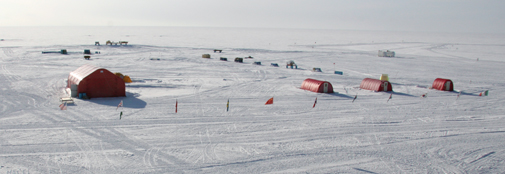Brittle ice is at hand

West side of camp, tidy and clean, as seen from the top of the main dome.
This morning the loggers, Bo and Susanne, were frustrated. The nice line
up of the table yesterday was not enough, and the first core fractured on
them. No core is lost, but it is frustrating to see a beautiful core
crack. Sverrir helped them setting up the saw and table, and the rest of
the day passed slowly, but luckily uneventful.
After dinner we had a discussion on the situation. In the discussion
participated people with brittle ice experience from Dye-3,GRIP, NGRIP,
EPICA Dome C, EPICA DML, Dome Fuji and Wais Divide. As Field Leader it is
a privilege to have such a team in camp. In the last 10 years, gas and CFA
analysis have become important part of modern ice core analysis, and since
the objective of NEEM is to compare our present climate with the previous
interglacial, the Eemian, our threshold on when to give up cutting the
ice and processing the ice is lower than before. At EPICA Dome C, the
brittle zone was declared at 585.20 m depth, At Wais Divide and DML it was
declared at almost the same depth.
Our plan is to continue logging the ice for processing for two more days.
Then we will declare brittle zone and stop logging the core immediately
after drilling. The core will be logged after 5 days in the buffer, as
experience shows that fitting and cutting in segments then is possible.
Saturday and Sunday, the processing line will be closed except for the CFA
lab. We will excavate a cooling tunnel for the science trench, so that
this will be in operation when the new team arrives.
The brittle zone. A note: Just as in the ocean, the pressure in ice sheets
increases with depth. That is why we need a drilling fluid in the hole to
counteract the pressure of the surrounding ice, otherwise our drill would
be squashed by ice flow. Glacier ice is compressed snow and thus it
contains bubbles of trapped air. It is this air that provides the vital
information on atmospheric content of green house gases in past climates.
However, with increasing depth, the air pressure in the bubbles increase
at the same rate as in the surrounding ice. In the ice drilled today, the
pressure in the bubbles is 50 bar, so even small forces on the ice core
will cause some bubbles to explode and the ice to crack. The ice is
brittle. If we handle the core like eggs, very carefully, and let the ice
relax over some days, it becomes less brittle. It may seem, that all is
lost when we get deeper and the pressure increases, but we are helped by
nature. At 1200 m depth, the brittle zone ends. Pressure in the bubbles is
more than 100 bar, and then the air is forced into solid solution in the
ice crystals forming the so called clathrate hydrates. The bubbles
disappear and the ice core becomes robust and tractable again. Later, in
our ice core storage, the ice relaxes, expands a little and the bubbles
re-appear without creating cracks in the ice.
What we have done today:
- Drilling with the NEEM long drill.
- Logging. Last bag: 971. Depth: 534.05 m.
- Processing 30.55 m. Processed depth: 329.45 m.
- Measurements in the CFA laboratory.
- Grooming skiway with tiller.
- Taking atmospheric sampling site down.
- Physical properties studies.
- Constructing funnel for the CFA lab.
Ad.1: This is how the drillers report looks today:
“Stable drilling except for repair work and tuning of the logging table.
Sebastian has been certified as consol operator.
We drilled 21.14 m in 6 runs; drillers depth 524.82 m.”
Ad.8: The CFA lab. produces so much heat, that we needed to funnel it out.
Weather: All day broken overcast of high clouds. -23 °C to -11 °C, 5-14
knots from S later SW.
Visibility: Unrestricted.
FL, J.P. Steffensen
| ← Previous entry | Next entry → |

